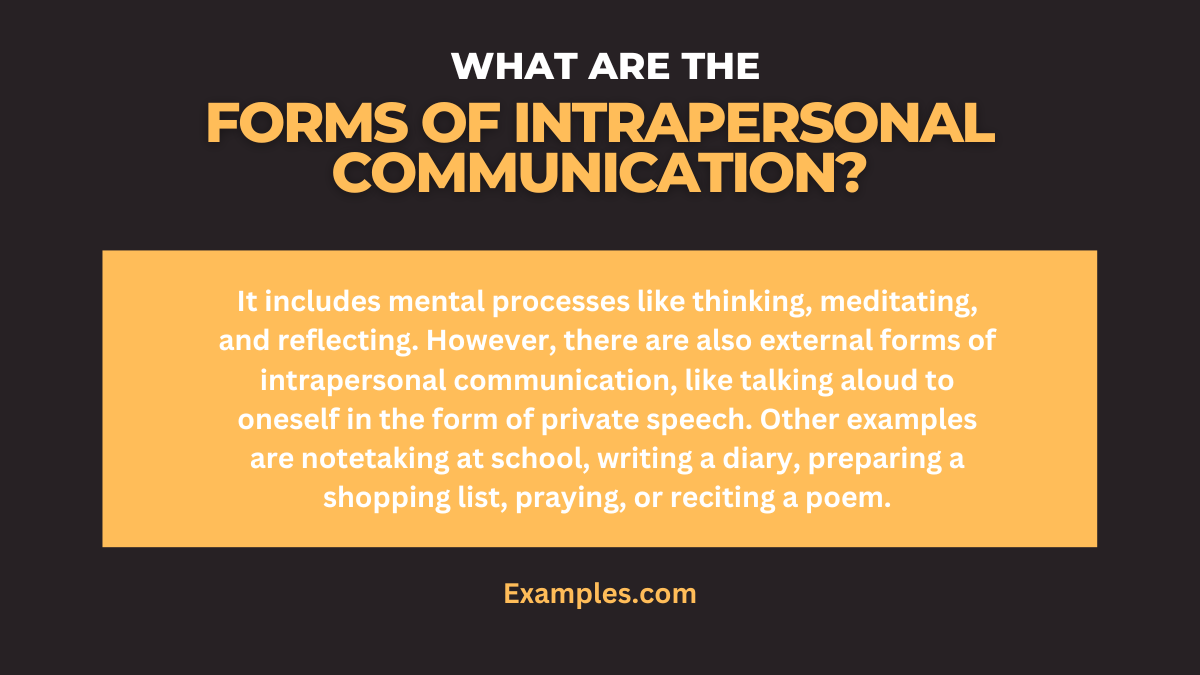7 Forms of Intrapersonal Communication Examples
Intrapersonal communication, the intimate art of conversing with oneself, is a cornerstone of personal development and self-awareness. This comprehensive guide illuminates the various forms of intrapersonal communication, enriched with practical Intrapersonal Communication Examples. From the silent whispers of self-talk to the profound depths of introspective meditation, each form plays a crucial role in shaping our thoughts, emotions, and actions. Delve into this exploration of the internal dialogue that guides our everyday life and decision-making processes.
What are the Forms of Intrapersonal Communication?

Intrapersonal communication is the process of communicating within oneself. It’s a form of dialogue that occurs internally, where an individual acts as both the sender and receiver of messages. This self-communication is crucial in shaping our thoughts, beliefs, and emotions. It encompasses various forms, such as self-talk, reflection, and daydreaming. Each of these forms contributes to our Intrapersonal Communication Skills and plays a vital role in personal growth and understanding. This concept is fundamental in Intrapersonal Communication Theories, aiding in self-analysis and decision-making.
Forms of Intrapersonal Communication

Intrapersonal communication is a multifaceted process integral to personal development and self-awareness. This type of communication occurs within an individual, involving thoughts, feelings, and internal dialogues. Understanding the different Forms of Intrapersonal Communication is crucial for enhancing self-knowledge, improving intrapersonal skills, and achieving personal goals.
Self-Talk
Self-talk, a critical aspect of intrapersonal communication, shapes our self-perception and decision-making. Positive self-talk enhances self-esteem and motivation, essential for personal growth. Engaging in constructive self-dialogue is a key intrapersonal communication skill, fostering a positive mindset and overcoming internal barriers.
Reflection
Reflection, a form of intrapersonal communication, involves analyzing past experiences to gain insights and learn. This process is vital for understanding one’s actions and their impact, aligning closely with intrapersonal communication theories like the Johari Window Model, which highlights the importance of self-awareness.
Journaling
Journaling serves as a powerful tool for intrapersonal communication, allowing individuals to express thoughts and emotions. This practice aligns with the Intrapersonal Model of Communication, facilitating self-discovery and emotional clarity. It’s an effective way to practice intrapersonal communication activities for personal insight.
Mindfulness and Meditation
Mindfulness and meditation are essential for effective intrapersonal communication. These practices focus on present-moment awareness, aiding in emotional regulation and stress reduction. They are key components of intrapersonal intelligence examples, promoting mental clarity and inner peace.
Creative Visualization
Creative visualization is a dynamic form of intrapersonal communication. It involves mentally simulating desired outcomes, a technique often used in intrapersonal learning styles. This method boosts motivation and aligns emotional and mental states with personal goals.
Goal Setting and Review
Goal setting and review are proactive forms of intrapersonal communication. This process involves defining objectives and monitoring progress, essential for personal development. Regular goal review is a crucial element in intrapersonal communication stages, ensuring alignment with personal values and ambitions.
Emotional Processing
Effective emotional processing is a vital form of intrapersonal communication. Identifying and managing emotions is key to informed decision-making and empathy development. This aspect is closely related to intrapersonal psychology, focusing on internal emotional dynamics.
Decision Making
Decision making is a complex form of intrapersonal communication that entails considering options and outcomes. This process is influenced by various intrapersonal factors, including personal values, experiences, and goals. Effective decision-making is crucial for both personal and professional success.
Problem-Solving
Problem-solving, an integral form of intrapersonal communication, requires critical thinking and creativity. This process is essential for overcoming challenges and achieving goals. Effective problem-solving is a testament to strong intrapersonal abilities and is often highlighted in intrapersonal communication examples.
Affirmations
Affirmations are positive statements used in intrapersonal communication to reinforce self-belief. Regularly practicing affirmations contributes to a positive mindset and resilience, key aspects of intrapersonal communication skills. This practice is beneficial for mental health and personal growth.
Introspection
Introspection involves examining one’s thoughts, feelings, and motivations. It’s a deep form of intrapersonal communication that leads to significant self-understanding. This process is central to various intrapersonal communication theories, offering insights into one’s inner workings.
In conclusion, these forms of intrapersonal communication are essential for personal development, emotional intelligence, and effective self-management. By understanding and practicing these different forms, individuals can enhance their relationship with themselves, thereby positively impacting their interactions in various life aspects, such as intrapersonal communication in the workplace, in school, and in everyday life.
Can Intrapersonal Communication be in the Form of Writing?

In the realm of personal communication, one often overlooks the power of writing as a form of intrapersonal communication. Yes, intrapersonal communication can indeed manifest through writing, a process that goes beyond mere self-expression. This form of communication is instrumental in clarifying thoughts, exploring deep emotions, and organizing complex ideas. Writing, whether it’s maintaining a journal, drafting letters to oneself, or even creating lists, serves as a reflective mirror, allowing an individual to converse with their inner self.
Writing as a form of intrapersonal communication is particularly significant in the context of intrapersonal communication skills. It enhances self-awareness, aids in decision-making, and contributes to emotional regulation. Additionally, writing can be a therapeutic tool, often used in various forms of therapy to help individuals understand and manage their thoughts and feelings. In the digital age, this takes on new forms, including digital journaling and note-taking apps, making intrapersonal communication through writing more accessible and varied.
Benefits of Writing in Intrapersonal Communication
- Enhances Clarity: Writing helps in organizing thoughts, providing clarity and structure to internal dialogues.
- Facilitates Emotional Release: It allows for an emotional outlet, helping to process complex feelings in a constructive manner.
- Aids in Goal Setting: Writing down goals and aspirations makes them more tangible and attainable.
- Promotes Self-Reflection: Regular writing encourages introspection, leading to greater self-understanding and personal growth.
What are Interpersonal and Intrapersonal Forms of Communication?

Understanding the nuances between interpersonal and intrapersonal communication is vital in grasping the full spectrum of human communication. Interpersonal communication refers to the exchange of information, feelings, and meanings between two or more individuals. This form of communication can occur in various contexts, including face-to-face interactions, telephone conversations, and digital communications. It involves not only verbal exchanges but also non-verbal cues such as body language, facial expressions, and tone of voice.
On the other hand, intrapersonal communication occurs within an individual. This internal dialogue encompasses thoughts, self-talk, reflections, and emotions. It’s a critical component of self-awareness, decision-making, and personal development. Intrapersonal communication shapes our perception of the world and ourselves, influencing our reactions and interactions with others.
Interconnections and Differences
- Interconnectedness: While distinct, both forms of communication are interconnected. Effective interpersonal communication often stems from clear and constructive intrapersonal communication.
- Skills Development: Skills developed in one form can enhance the other. For example, clarity in intrapersonal communication can lead to more effective interpersonal communication.
- Differing Contexts: Intrapersonal communication is a solitary activity, focusing on self-reflection and personal insight. In contrast, interpersonal communication is social, involving exchange and interaction with others.
The Role of Each in Personal and Professional Life
- Intrapersonal Communication: Plays a crucial role in self-development, emotional intelligence, and personal goal achievement.
- Interpersonal Communication: Essential for building relationships, teamwork, and effective communication in professional settings.
In conclusion, understanding the Elements of Intrapersonal Communication is key to personal growth and effective self-expression. This guide offers valuable insights and practical tips on harnessing these elements for enhanced self-awareness and communication skills. Embracing these principles can lead to more meaningful self-dialogues and a profound understanding of one’s thoughts and emotions.



